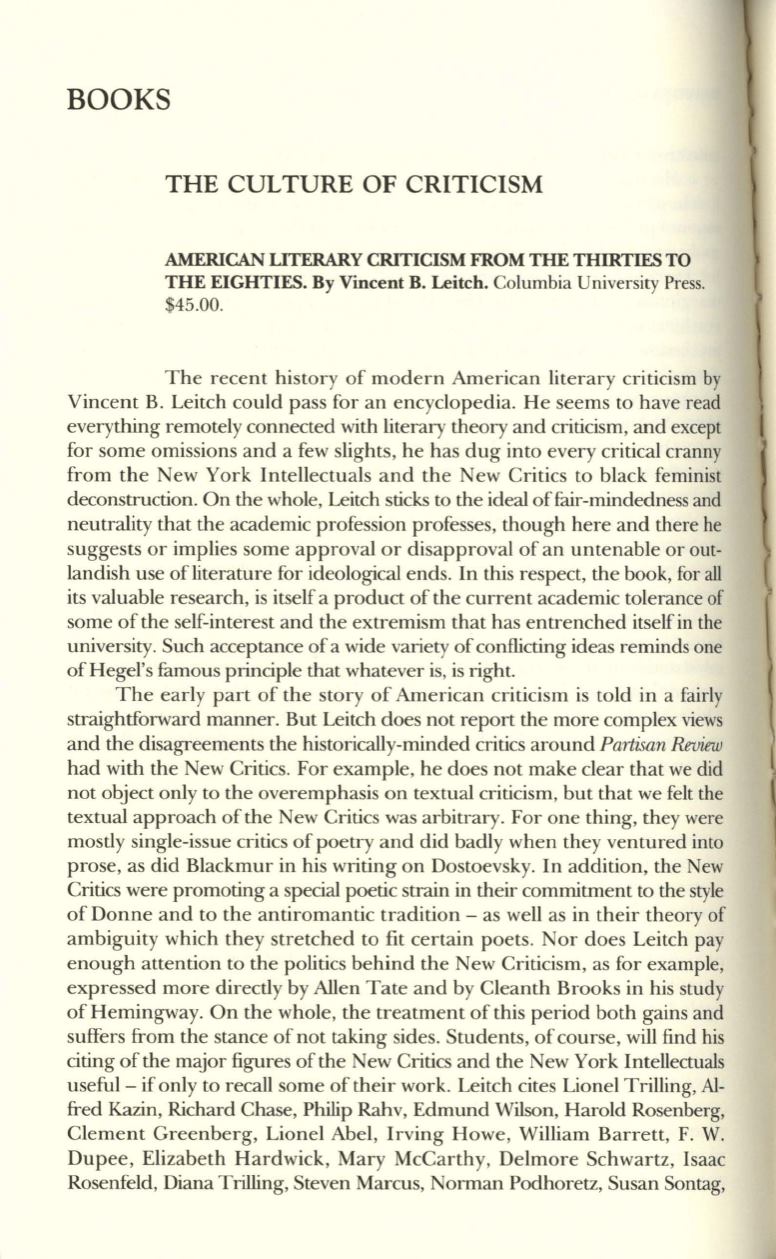
BOOKS
THE CULTURE OF CRITICISM
AMERICAN LITERARY CRITICISM FROM THE THIRTIE'S TO
THE EIGHTIES. By
Vincent
B.
Leitch. Columbia University Press.
$45.00.
The recent history of modern American literary criticism by
Vincent B. Leitch could pass for an encyclopedia. He seems to have read
everything remotely connected with literary theory and criticism, and except
for some omissions and a few slights, he has dug into every critical cranny
from the New York Intellectuals and the New Critics to black feminist
deconstruction. On the whole, Leitch sticks to the ideal of fair-mindedness and
neutrality that the academic profession professes, though here and there he
suggests or implies some approval or disapproval of an untenable or out–
landish use ofliterature for ideological ends. In this respect, the book, for
all
its valuable research, is itself a product of the current academic tolerance of
some of the self-interest and the extremism that has entrenched itself in the
university. Such acceptance of a wide variety of conflicting ideas reminds one
of Hegel's famous principle that whatever is, is right.
The early part of the story of American criticism is told in a fairly
straightforward manner. But Leitch does not report the more complex views
and the disagreements the historically-minded critics around
Partisan Review
had with the New Critics. For example, he does not make clear that we did
not object only to the overemphasis on textual criticism, but that we felt the
textual approach of the New Critics was arbitrary. For one thing, they were
mostly single-issue critics of poetry and did badly when they ventured into
prose, as did Blackmur in his writing on Dostoevsky. In addition, the New
Critics were promoting a special poetic strain in their commitment to the style
of Donne and to the antiromantic tradition - as well as in their theory of
ambiguity which they stretched to fit certain poets. Nor does Leitch pay
enough attention to the politics behind the New Criticism, as for example,
expressed more directly by Allen Tate and by Cleanth Brooks in his study
of Hemingway. On the whole, the treatment of this period both gains and
suffers from the stance of not taking sides. Students, of course, will find his
citing of the major figures of the New Critics and the New York Intellectuals
useful- if only to recall some of their work. Leitch cites Lionel Trilling, Al–
fred Kazin, Richard Chase, Philip Rahv, Edmund Wilson, Harold Rosenberg,
Clement Greenberg, Lionel Abel, Irving Howe, William Barrett, F. W.
Dupee, Elizabeth Hardwick, Mary McCarthy, Delmore Schwartz, Isaac
Rosenfeld, Diana Trilling, Steven Marcus, Norman Podhoretz, Susan Sontag,


